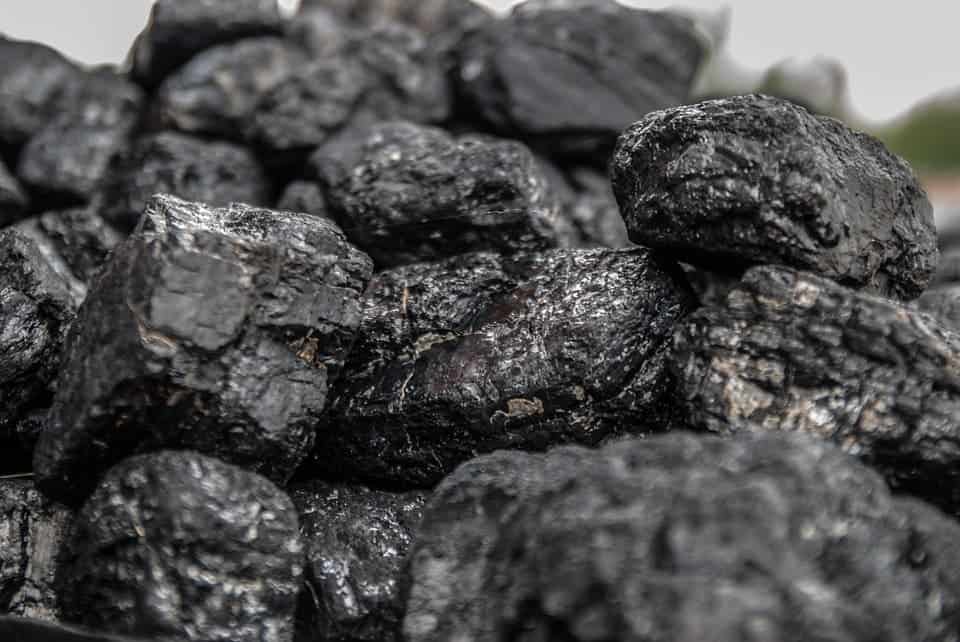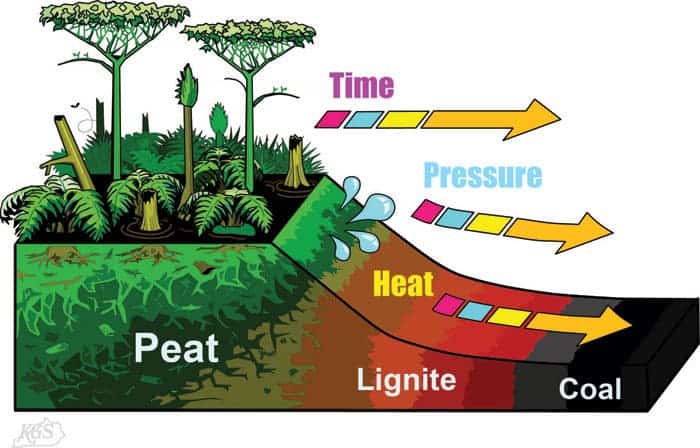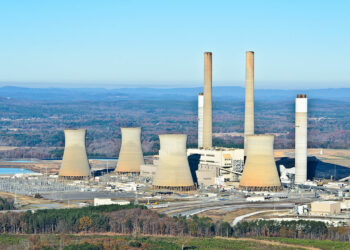Coal, one of the world’s most impactful fossil fuels, was formed millions of years ago, in very specific conditions.
Most of the coal on Earth formed approximately 300 million years ago from the remains of trees and other vegetation. Large trees, ferns, and other plants grew in warm, humid places; eventually, they fell down into the swampy water, where they were covered by mud and other sediments.
These remains became trapped on the bottom of swamps, accumulating layer after layer and creating a dense material called peat. Year after year (or rather, millions of years after millions of years), this peat was buried more and more underground, where it was subjected to higher pressure and temperatures. This change in physical conditions triggered chemical reactions that ultimately transform the material into coal.
But that’s just the short story.
Coal Formation

Coal is still one of the largest sources of energy worldwide, although it’s being phased out in many parts of the world due to its climate impact (we’ll get to that a bit later).
But if we want to understand the origins of coal, we have to look back much further — to a period called the Carboniferous.
How coal is formed
The Carboniferous (named after the Latin word for ‘coal’) is a geological period that lasted from approximately 360 to 300 million years ago. It was before the age of the dinosaurs when amphibians were the dominant land vertebrates and vast swaths of huge trees covered the singular mega-continent Pangaea.
The planet’s atmosphere was also different from what it is today; the atmospheric content of oxygen was at its highest level in history: 35%, compared with 21% today. Although it may not be intuitive at first, all these conditions were just right for the formation of coal.
Coal never formed before the Carboniferous, and very rarely formed after it. Two conditions are regarded as crucial for this event. The first of these is the emergence of wooden trees with bark.
Trees started evolving bark and underwent biochemical changes that would make their mass more suitable for an eventual transformation to coal. But the key was timing: a large quantity of wood was buried peacefully in this period because mushrooms and microorganisms hadn’t yet figured out how to decompose trees. In other words, vast areas of fallen trees just lay there and had time to be covered by sediments and undergo the processes that transform plant mass into coal. After these microorganisms did evolve, coal formations became much rarer because the trees would be decomposed before being buried.
The second key element was the lower sea level. The decrease of the sea level created many swampy environments in what is today North America and Europe. These swamps were vital for coal formation as they provided the perfect environment where the un-decomposed trees could be buried.

The transformation of trees into coal then became a story of heat, pressure, and time. First, the mass transformed to peat, an accumulation of partially decayed vegetation or organic matter. Peat typically forms in waterlogged conditions. But peat is not coal.
In order for a peat area to continue transforming into coal (and not remain a peatland), more sediment and time is needed. As more sediment piled up on top of the peat, the pressure and heat increase, causing the peat to undergo further chemical changes. These changes resulted in the formation of different types of coal, such as lignite, bituminous coal, and anthracite.
However, some recent research suggests that there may also be ways through which coal can be formed.
“If you polled geochemists, most would say that coal was created by temperature, acids or catalysts,” said Max K. Lloyd, assistant research professor of geosciences, Penn State. “But our results are inconsistent with those mechanisms. They show that microbes are directly consuming coal methoxyl groups, transforming coal and making methane.”
“The challenge to coal bed methane production is that creating wells is very expensive and the well may run dry in a month,” said Lloyd. “We don’t know why. Producers add more microbes or more nutrition (for the microbes), but that only works if those are the limiting factors, not if the coal itself is the limiting factor.”
Furthermore, other coal experts suggest that it may not be the bacteria that formed the coal but other conditions from the Carboniferous.
“Much of the scientific community was really enamored with this simple, straightforward explanation,” said Kevin Boyce, a geobiologist at Stanford’s School of Earth, Energy & Environmental Sciences. “So, it has not only refused to die, it has become a conventional wisdom.”
“If you want to generate coal, you need a productive environment where you’re making lots of plant matter and you also need some way to prevent that plant matter from decaying. Where that happens is in wet environments,” Boyce said.
“So you need both a wet tropics and a hole to fill. We have an ever-wet tropics now, but we don’t have a hole to fill,” Boyce said. “There’s only a narrow band in time in the Earth’s history where you had both a wet tropics and widespread holes to fill in the tropics, and that’s the Carboniferous.”
It’s remarkable that we’re still learning so much about how coal was formed, but new research on coal formation is still coming in.
Types of coal
The geological process of changing something under the effect of temperature and pressure is called metamorphism. Coal is considered a sedimentary rock, not a metamorphic rock because it undergoes only low-temperature thermochemical changes — in order for a rock to be considered metamorphic, it would need to undergo far more changes.
Still, coal has been metamorphized somewhat, and the different types of coal are generally classified based on the grade of metamorphism. In general, the higher the grade of metamorphism, the higher-quality the coal (this means a coal that has more embedded energy)

These are the main types of coal:
- peat is generally considered a precursor of coal, but it has been used as a fuel in some areas — most notably in Ireland and Finland. In its dehydrated form, it can help soak up oil spills.
- lignite is the lowest quality and the first to be formed.
- sub-bituminous coal is most often used as fuel for steam-electric power generation.
- bituminous coal is a dense sedimentary rock, generally of high quality.
- “steam coal” is a transition type between bituminous and anthracite.
- anthracite is the highest rank of coal. It’s a hard, glossy rock and is highly valued for its properties.
- graphite is not generally considered a type of coal because it cannot be used for heating. It is most often used in pencils or as a lubricant (when powdered).
Coal can be used in its natural form, or it can be either gasified, liquefied, or refined. However, no matter the type of coal or how you use it, coal is a non-renewable resource. In realistic terms, no coal is being formed to restock the resources we are using.
Coal and climate change
Coal was the key material that sparked the Industrial Revolution, essentially paving the way for what we now consider to be modern society. But coal has become a problem.
Coal is one of the main contributors to global warming, and coal mining and its fueling of power stations cause major environmental damage.
Historically, coal mining has been very dangerous. The list of coal mine accidents is long, and even today, accidents are still surprisingly common. Many miners also suffer from coalworker’s pneumoconiosis, colloquially known as “black lung”. But the main problem with coal is its emissions.
In 2008 the World Health Organization (WHO) calculated that coal pollution alone is responsible for one million deaths annually across the world; other organizations have come up with similar figures. According to a US report published in 2004, coal-fired power plants shorten nearly 24,000 lives each year in the US (2,800 from lung cancer). In China, the situation is even more dire as smog is a common occurrence in many major Chinese cities.
But the biggest problem with coal is its greenhouse gas emissions. Coal releases greenhouse gases into the atmosphere, which causes our planet’s atmosphere to retain more heat, triggering what we now call global heating. Even when compared to other fossil fuels like natural gas, coal is much more problematic and yields far more emissions per unit of energy.
Burning coal releases great quantities of carbon dioxide into the air and also releases methane — a much more potent greenhouse gas. Methane accounts for 10.5% of greenhouse gas emissions created through human activity.
It’s pretty much the last chance we get to phase coal out effectively.
“It’s really a make-or-break moment,” says Stephen Bi from the Potsdam-Institute for Climate Impact Research (PIK) and Potsdam University, who studied coal phasing. “Our computer simulation of climate economics and policy making indicates that current policies lead the world to less than a 5 percent likelihood of phasing out coal by mid-century. This would leave minimal chances of reaching net-zero emissions by 2050 and limiting disastrous climate risks.”
“The most shocking result was that even though most countries decide to stop burning coal for electricity during the simulation, this has almost zero impact on total future coal use,” says Bi. “We then dug deeper into this perplexing result to identify what policymakers can do to actually achieve the coal exit.”
Coal may have allowed the industrial revolution to take place, but if we want to build a sustainable future, we simply have to phase out coal and implement other sources of energy in its stead. If we fail to do that and keep relying on fossil fuels like coal, we will face a catastrophic climate future.







